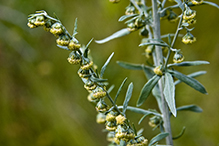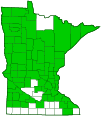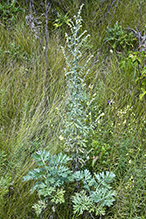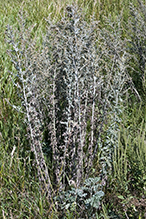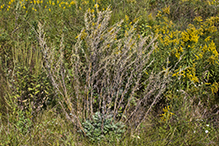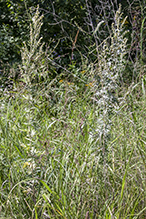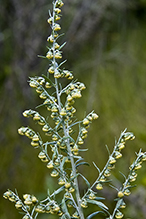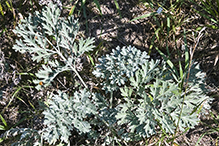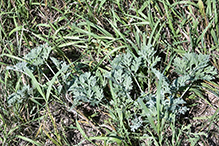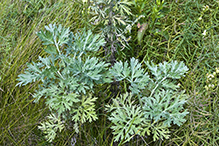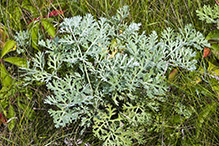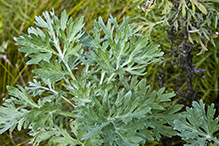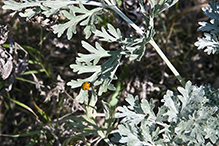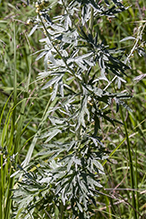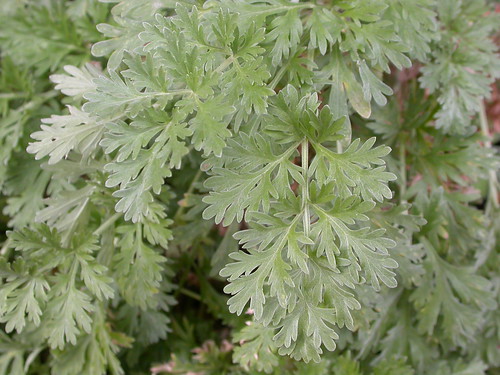absinthe wormwood
(Artemisia absinthium)
Conservation • Description • Habitat • Ecology • Use • Distribution • Taxonomy
Conservation Status |
|
|||||||
| IUCN Red List | not listed |
|||||||
| NatureServe | NNA - Not applicable SNA - Not applicable |
|||||||
| Minnesota | not listed |
|||||||
Description |
||
Absinthe wormwood is a common, exotic, herbaceous plant. It is native to Europe, Asia, and north Africa. It has been widely cultivated both as an ornamental and as an ingredient in green, anise-flavored spirit absinthe. It was introduced and cultivated in North America. It escaped cultivation and is now widely naturalized throughout the United States and southern Canada. It is found in old fields, pastures, waste places, old homestead sites, and other disturbed sites; and on roadsides, fencerows, and streambanks. It grows under full or partial sun in moist to moderately dry, well-drained, loamy, clayey, or gravelly soil. It is considered a weed in pastures but it does not have a formal weed status in any state. Absinthe wormwood is a 16″ to 40″ tall, erect, long-lived, perennial forb that rises on up to 20 or more stems from a stout, woody taproot. Like most Artemisia species, the leaves and stem are strongly aromatic when bruised. The stems are erect or ascending, usually branched, and sometimes woody near the base. When young they are densely covered with short, silky hairs, giving them a grayish-green appearance. Older stems sometimes become nearly hairless. Basal leaves are deciduous, up to 8″ long, and on long leaf stalks. They do not have stipule-like lobes or teeth at the base. They are deeply cut into 3 or 5 primary lobes (pinnatifid). The primary lobes are again divided into secondary lobes (bipinnatifid), which may be once more lobed (3 times pinnatifid). The ultimate lobes are inversely egg-shaped, 1 ⁄16″ to ⅛″ wide, and are rounded at the tip. When young, the upper and lower surfaces are densely covered with short, silky hairs, giving them a grayish-green appearance. The upper surface of mature leaves is sometimes nearly hairless. The margins are untoothed. Lower stem leaves are similar, alternate, 2″ to 4″ long, and on shorter leaf stalks, becoming even smaller, less divided, and on shorter stalks as they ascend the stem. The uppermost leaves may be undivided and stalkless. The inflorescence is an open, leafy, elongated, branched cluster (panicle) of at the end of the stems and branches. The panicles are 4″ to 8″ long or longer, 4″ to 5″ wide or wider, and have numerous flower heads. The flower heads small and inconspicuous and droop downward. The whorl of bracts at the base of the flower head (involucre) is broadly egg-shaped, 1 ⁄16″ to ⅛″ long, and ⅛″ to 3 ⁄16″ wide. The bracts of the involucre are densely covered with silky hairs and have broad, thin, papery, transparent margins and tip. There are no ray florets. The disk has female (pistillate) florets as well as florets that have both male and female parts (perfect). On the margin of the disk are 9 to 20 pale yellow, pistillate florets. In the center are 30 to 50 pale yellow, perfect florets. The fruit is a tiny achene. |
||
Height |
||
16″ to 40″ |
||
Flower Color |
||
Pale yellow |
||
Similar Species |
||
Mugwort (Artemisia vulgaris) has leaves with a green, hairless upper surface and ultimate lobes that are sharply pointed. The flower heads are smaller |
||
Habitat |
||
Old fields, pastures, waste places, old homestead sites, disturbed sites, roadsides, fencerows, and streambanks |
||
Ecology |
||
Flowering |
||
July to September |
||
Pests and Diseases |
||
|
||
Use |
||
Absinthe wormwood is planted as an ornamental for its attractive grayish-green foliage. It is a key ingredient in the spirit absinthe. |
||
Distribution |
||||
|
Sources |
|||
| 1/31/2023 | ||||
Nativity |
||||
Native to Europe, Asia, and north Africa. Introduced and naturalized in North America |
||||
Occurrence |
||||
Common |
||||
Taxonomy |
|||
| Kingdom | Plantae (Plants) | ||
| Division | Tracheophyta (Vascular Plants) | ||
| Subdivision | Spermatophytina (Seed Plants) | ||
| Class | Magnoliopsida (Dicots) | ||
Order |
Asterales (Sunflowers, Bellflowers, Fanflowers, and Allies) | ||
Family |
Asteraceae (Sunflowers, Daisies, Asters, and Allies) | ||
| Subfamily | Asteroideae | ||
| Supertribe | Asterodae | ||
| Tribe | Anthemideae (chamomiles, yarrows, and allies) | ||
| Subtribe | Artemisiinae | ||
| Genus | Artemisia (wormwoods and sagebrushes) | ||
Synonyms |
|||
Artemisia absinthium var. absinthium Artemisia absinthium var. insipida |
|||
Common Names |
|||
absinth absinth sagewort absinth sage-wort absinthe wormwood absinthe absinthe wormwood absinthium common sagewort common sage-wort common wormwood grand wormwood mugwort sage-wort wormwood sage wormwood |
|||
Glossary
Achene
A dry, one-chambered, single-seeded seed capsule, formed from a single carpel, with the seed attached to the membranous outer layer (wall) only by the seed stalk; the wall, formed entirely from the wall of the superior ovary, does not split open at maturity, but relies on decay or predation to release the contents.
Bipinnatifid
Twice pinnatifid. Cut deeply into lobes with each lobe also cut into deep lobes.
Involucre
A whorl of bracts beneath or surrounding a flower, flower head, or flower cluster.
Panicle
A pyramidal inflorescence with a main stem and branches. Flowers on the lower, longer branches mature earlier than those on the shorter, upper ones.
Perfect
Referring to a flower that has both male and female reproductive organs.
Pinnatifid
Deeply cut, more than half way to the midrib but not to the midrib, into lobes that are spaced out along the midrib; the lobes do not form separate leaflets.
Pistillate
Referring to a flower that has a female reproductive organ (pistil) but does not have male reproductive organs (stamens).
Stipule
A small, leaf-like, scale-like, glandular, or rarely spiny appendage found at the base of a leaf stalk, usually occurring in pairs and usually dropping soon.
Traditional Absinthe is Still Illegal in the U.S.
Absinthe was banned in the United States in 1912 because it was believed to be hallucinogenic and dangerous. The reason for the concern was the psychoactive chemical compound thujone, which is contained in the plant absinthe wormwood.
According to Absinthe Original, makers of absinthe in London, England,
For those who are unfamiliar, thujone is to absinthe what caffeine is to coffee: it is what gives it its "buzz". It's the ingredient that pretty much defines absinthe as a drink, the ingredient that distinguishes it from any other alcoholic beverage ever created.
In 2007, the U.S. Food and Drug Administration and the Alcohol Tobacco Tax and Trade Bureau authorized the sale of absinthe that is thujone-free, meaning that the thujone level is less than 10 parts per million (ppm). Absinthe in Europe and the United Kingdom contains 35 ppm. This “American absinthe” is not sold outside the United States because no one would buy it.


Visitor Videos |
|||
Share your video of this plant. |
|||
| This button not working for you? Simply email us at info@MinnesotaSeasons.com. Attach a video, a YouTube link, or a cloud storage link. |
|||
Other Videos |
|||
| Artemisia absinthium (Absinthe) TeachEthnobotany |
|||
About
Uploaded on Nov 29, 2011 Michael Clanahan gives a presentation on the medicinal properties of Artemisia absinthium, commonly known as wormwood and the source of absinthe. In this talk, he discusses the botanical and chemical characteristics of the plant, as well as its known biological activities. This medicinal plant monograph presentation was recorded on November 28th, 2011 as part of Dr. Cassandra L. Quave's undergraduate course entitled "Botanical Medicine and Health" offered at Emory University. DISCLAIMER: Content provided in this video and the YouTube TeachEthnobotany site is for educational purposes only and should not be construed to be medical advice, diagnosis or treatment. This content is not a substitute for professional medical or healthcare advice, diagnosis or treatment, and may not be used for such purposes. The information about herbal medicines and drugs in this video and the TeachEthnobotany site is general in nature. It does not cover all possible uses, actions, precautions, side effects, or interactions of the medicines mentioned, nor is the information intended as medical advice for individual problems or for making an evaluation as to the risks and benefits of taking a particular drug or botanical/herbal medicine. Always seek the advice of your physician or other qualified health provider with any questions you may have regarding a medical question or condition. |
|||
| Wormwood herb: Artemisia absinthium HerbMentor |
|||
About
Uploaded on Jan 25, 2009 http://FreeHerbCourse.com Wormwood herb, Artemisia absinthium and wormwood uses. how to harvest wormwood, how to grow wormwood. Learn about wormwood in this informative video. |
|||
| 'Poisonous Plants 1-2-1' Artemisia absinthium, wormwood John Robertson |
|||
About
Published on Dec 31, 2013 The story of wormwood, used to flavour absinthe, in 121 seconds. For more information on the plant please visit http://www.thepoisongarden.co.uk/atoz/artemisia_absinthium.htm Or, for a detailed look at absinthe see http://www.thepoisongarden.co.uk/atoz/absinthe.htm |
|||
| Weed of the Week #670-absinthe wormwood (Air Date 2/6/11) AgPhD |
|||
About
Uploaded on Feb 10, 2011 No green fairies here. It's our Weed of the Week, absinthe wormwood. |
|||

Visitor Sightings |
|||||
Report a sighting of this plant. |
|||||
| This button not working for you? Simply email us at info@MinnesotaSeasons.com. Be sure to include a location. |
|||||
|
|||||
MinnesotaSeasons.com Sightings |
|||||
Avon Hills Forest SNA, North Unit Blazing Star Prairie Addition Preserve, South Unit Felton Prairie SNA, Bicentennial Unit Felton Prairie SNA, Shrike Unit Minnesota Valley NWR, Rapids Lake Unit Minnesota Valley NWR, Wilkie Unit Mound Spring Prairie SNA, North Unit Mound Spring Prairie SNA, South Unit Northern Tallgrass Prairie NWR, Rengstorf Unit Pembina Trail Preserve SNA, Crookston Prairie Unit Sand Prairie Wildlife Management and Environmental Education Area |
|||||

|
Created: Last Updated: © MinnesotaSeasons.com. All rights reserved. |
